
3rd Issue 2006
Feature Articles
1. Control of Food Temperature
Hello everybody! It's me again, the Miss Reporter Belittle! You must be concerned about the recent spate of food poisoning incidents in Hong Kong . Like all of you, I take food safety very seriously. To minimise the risk of food poisoning, we must control food temperature and the keeping time properly. Let's find out more about how.
Importance of food temperature control
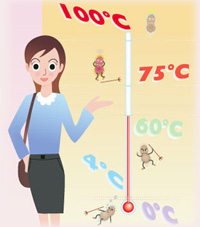 Food stored at the "Temperature Danger Zone" between 4°C and 60°C allows various types of bacteria, such as salmonella, Staphylococcus aureus and Vibrio parahaemolyticus, to grow rapidly. Proper temperature control at all stages of food preparation process is an effective way to prevent bacterial food poisoning. While low temperature storage will inhibit bacterial growth, high temperature treatment can destroy bacteria effectively.
Food stored at the "Temperature Danger Zone" between 4°C and 60°C allows various types of bacteria, such as salmonella, Staphylococcus aureus and Vibrio parahaemolyticus, to grow rapidly. Proper temperature control at all stages of food preparation process is an effective way to prevent bacterial food poisoning. While low temperature storage will inhibit bacterial growth, high temperature treatment can destroy bacteria effectively.
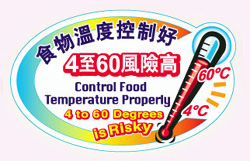 To prevent bacterial growth, food should be kept at proper temperature. Avoid the "Temperature Danger Zone" between 4°C and 60°C .
To prevent bacterial growth, food should be kept at proper temperature. Avoid the "Temperature Danger Zone" between 4°C and 60°C .
To destroy bacteria, food should be cooked or reheated thoroughly until its core temperature reaches at least 75°C.
Tips for proper control of food temperature
- Storage
- Perishable food (such as milk and meat) should always be kept at temperature of either:
* 4°C or below; or
* 60°C or above. - Chilled and frozen food should be stored in the fridge at 4°C or below and in the freezer at -18°C or below respectively.
- Perishable food should be consumed before the expiry date.

- Perishable food (such as milk and meat) should always be kept at temperature of either:
- Thawing
- Frozen food should not be thawed at room temperature. The proper ways of thawing should be done:
* in a refrigerator (0° - 4°C);
* under cold running water; or
* in a microwave oven.
- Frozen food should not be thawed at room temperature. The proper ways of thawing should be done:
- (3.) Cooking / reheating
- Food should be cooked or reheated thoroughly until its core temperature reaches at least 75°C. Food thermometer can effectively measure and monitor food temperature.
- (4.) Food display
- Check if the foods on display in food premises or on buffet tables are kept at the appropriate temperature.
- Perishable food should be displayed at either:
* 4°C or below; or
* 60°C or above. - If food is stored, delivered and displayed within the "Temperature Danger Zone", the total keeping time should not exceed 4 hours.
2. Guidelines on Voluntary Labelling of Genetically Modified Food
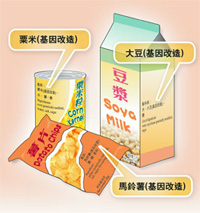 To enhance consumers' knowledge and help them make informed choice on genetically modified (GM) food, the Centre for Food Safety has issued Guidelines on Voluntary Labelling of Genetically Modified Food (the Guidelines) in July. The Guidelines set out the principles underlying the recommended labelling approaches for GM food, and provide reference for the trade to make truthful and informative labels in a consumer-friendly manner. Although the Guidelines are advisory in nature and have no legal power, the trade is encouraged to adopt the Guidelines to standardise the information presented to consumers who can then make appropriate choice according to individual needs when purchasing food.
To enhance consumers' knowledge and help them make informed choice on genetically modified (GM) food, the Centre for Food Safety has issued Guidelines on Voluntary Labelling of Genetically Modified Food (the Guidelines) in July. The Guidelines set out the principles underlying the recommended labelling approaches for GM food, and provide reference for the trade to make truthful and informative labels in a consumer-friendly manner. Although the Guidelines are advisory in nature and have no legal power, the trade is encouraged to adopt the Guidelines to standardise the information presented to consumers who can then make appropriate choice according to individual needs when purchasing food.
Labelling of GM food aims to protect the consumers' right to know. However, it does not imply that the foods labelled as GM food are less safe than the conventional ones. The World Health Organization (WHO) stated that GM foods currently available on the international market have passed safety assessments and are not likely to pose risks to human health. To date, none of the GM foods in the market have been shown to be unfit for human consumption.
Format of Labels of GM Food
It is recommended in the Guidelines that any prepackaged food items with 5% or more GM materials in their respective food ingredient(s) could be labelled as "genetically modified" in brackets following the name of the food/ food ingredient in the "List of Ingredients" or in a prominently displayed footnote to the "List of ingredients".
The recommended formats for labelling are shown below:
List of Ingredients: water, soya beans (genetically modified), sugar
Or
List of Ingredients: water, soya beans*, sugar
* genetically modified
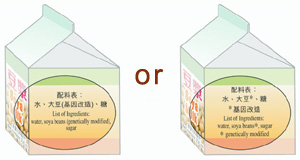
Additional declaration on the food label is recommended when significant modifications have taken place under the following conditions: –
- the composition or nutritional value is significantly different from that of its conventional counterpart;
- the level of anti-nutritional factors or natural toxicants is significantly different from that in its conventional counterpart;
- the presence of an allergen that is not found in its conventional counterpart;
- the intended use of the food is significantly different from that of its conventional counterpart; or
- an animal gene has been introduced into food of plant origin.
How to Label Non-GM Food
Under the current legislation, members of the trade should not falsely describe their food products. Since there is possibility of unintentional mixing of GM and non-GM crops, a truly "GM free" status is very difficult to attain. Therefore, absolute terms such as "GM free", "GMO free", "free from GM ingredients" and similar labels are not recommended as such absolute terms would be misleading to consumers.
If a food product is labelled as non-GM or other similar declarations, the trade needs to have documentation to substantiate that their product is made from non-GM source, or all ingredients in the product are derived from non-GM sources for those products containing multiple ingredients.
Consumers can lodge complaint with the Food and Environmental Hygiene Department should they have doubts on the labelling of GM food product.
For further information about the Guidelines and GM food, please visit the website of the Centre for Food Safety at www.cfs.gov.hk
Food Safety Plan Corner
Food Safety Guidelines for the Elderly
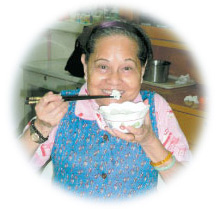 "Old folk are family treasures". As they are generally weaker in body resistance, we should pay attention to and prevent possible risks when preparing meals for them.
"Old folk are family treasures". As they are generally weaker in body resistance, we should pay attention to and prevent possible risks when preparing meals for them.
Key points to note when preparing meals for the elderly:
- Purchase ingredients from reliable and reputable retailers;
- Adopt "first-in-first-out" method for food storage and retrieval;
- Keep raw and cooked foods on different shelves of refrigerators: put cooked foods above raw ones to prevent cross-contamination;
- Cook all the foods thoroughly. Use a thermometer to ensure that the core temperature of food has reached 75 °C or above;
- Adopt the "cook-and-serve" system to shorten food preparation time as far as practicable;
- Carefully handle cooked foods that need further processing after cooking (e.g. blending into a smooth puree);
- Clean and sanitize all food contact surfaces thoroughly (especially blenders for cooked food and feeding spoons);
- Store cooked foods in insulated containers and keep them at 60°C or above;
- Maintain good personal hygiene practices. Wash hands with liquid soap for at least 20 seconds before handling food or after using toilets.
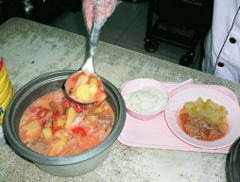
Advice to the elderly and homes for the elderly
- Consume the meal as soon as possible and try to finish the food in one go;
- If problems are identified, ask the elderly to stop consumption immediately to prevent food incidents and contact the caterers and the Food and Environmental Hygiene Department for follow-up actions.
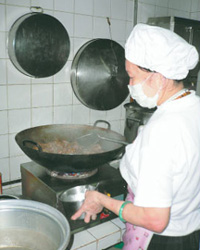 To safeguard food safety in the homes and services centres for the elderly, the Centre for Food Safety (CFS) and the Social Welfare Department jointly organize a promotional programme in 2006 on food safety of catering services for the elderly for the officers-in-charge of these establishments and their staff. Through this programme, risk factors in preparing meals for the elderly will be analyzed and precautionary measures recommended in order to enhance food safety standard. For more information, please contact the Risk Communication Section of the CFS on 2867 5610.
To safeguard food safety in the homes and services centres for the elderly, the Centre for Food Safety (CFS) and the Social Welfare Department jointly organize a promotional programme in 2006 on food safety of catering services for the elderly for the officers-in-charge of these establishments and their staff. Through this programme, risk factors in preparing meals for the elderly will be analyzed and precautionary measures recommended in order to enhance food safety standard. For more information, please contact the Risk Communication Section of the CFS on 2867 5610.
Readers' Corner
Food Safety Case Study
What is organic food?
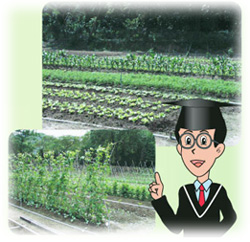 Welcome to the "Readers' Corner". This is your host, the Food Safety Wunderkind. Recently, a reader wrote to us, asking what organic food is. I think many of you would like to know too. Let me tell you what in fact organic food is.
Welcome to the "Readers' Corner". This is your host, the Food Safety Wunderkind. Recently, a reader wrote to us, asking what organic food is. I think many of you would like to know too. Let me tell you what in fact organic food is.
Organic food is different from conventional food mainly because it is produced according to organic standards throughout the production, processing and handling stages, and certified by a certification body or authority of the countries of origin. Organic standards include:
- for planting, avoid using chemical pesticides and fertilizers, but emphasize crop rotation, animal and plant manures, hand weeding and biological pest control;
- for raising animals, avoid using antibiotics, growth hormones and other animal feed additives; and
- no application of genetic modification and ionizing radiation.
How to know if the food is organic?
Organic farming avoids using chemical pesticides and veterinary drugs, organic food products and therefore have less chemical residues. The labels on organic food products usually indicate that they have been certified as "organic" by a certification body or authority. Locally produced organic food is mainly vegetables. Processed organic food products such as dried beans, soya milk, breakfast cereals, cookies, etc. and organic animal products like eggs are imported for sale in Hong Kong .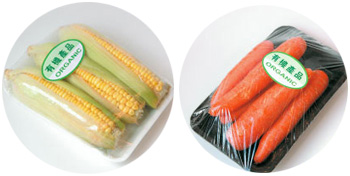
Advice to Consumers:
- From a nutritional point of view, there are no distinct differences between food produced according to organic standards and those by conventional method. The public should maintain a balanced diet, which includes fruit, vegetable, cereals, meat and milk, in order to obtain all the necessary nutrients for staying healthy.
- The general rules apply when purchasing organic products. For example, do not buy vegetables that look unfresh or mouldy.
- All food must be thoroughly washed and cooked.
FEHD has published a pamphlet on "Know more about organic food". Please visit the website at http://www.fehd.gov.hk/english/pestcontrol/library/organic_food/1.html.
Activity Highlights
International Symposium on Food Safety
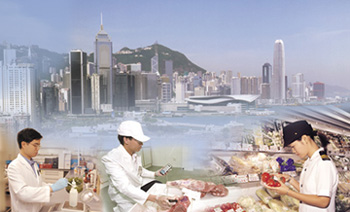
The International Symposium on Food Safety, organized by the Centre for Food Safety, will be held in January 2007. The objectives of the Symposium are to bring together the Mainland, international and local food safety professionals to share their experience and expertise on food safety management and control measures as well as to foster partnership and promote collaboration. Speakers will come from the Mainland, overseas and local food safety authorities and academic institutions.
The target audience of the Symposium are food safety experts, academics, government officials responsible for food safety, policy makers, members of relevant advisory bodies and committees, members of the food trade and students. Details of the Symposium are as follows:
| Date: | 12 and 13 January 2007 (Friday and Saturday) |
|---|---|
| Time: | 9 a.m. to 5 p.m. |
| Venue: | Kowloon Shangri-La Hotel, 64 Mody Road, Tsimshatsui, Kowloon , Hong Kong . |
| Fee: | HK$500 for two days |
| (per head) | HK$300 for one day |
| HK$200 for full-time students |
The Symposium will be conducted in English and Putonghua (with simultaneous interpretation).
For more information about the Symposium and to download the registration form, please visit the website at http://www.cfs.gov.hk/symposium.html , or contact Swire Travel Ltd., the organizing agent, on 3151 8900, or by email at foodsafety2007@swiretravel.com .
Interpretation of Ordinance
Harmful Substances in Food Regulations
At present, the Public Health and Municipal Services Ordinance (Cap. 132) requires that the food for sale in Hong Kong shall be fit for human consumption while its subsidiary legislation, the Harmful Substances in Food Regulations (the Regulations) regulates the import and sale of food containing harmful substances. According to the Regulations, any person who imports, manufactures or sells, for human consumption, any food containing certain substances specified in the regulations in greater concentration than the specified maximum concentration commits an offence and is liable to a maximum fine of $ 50,000 and to imprisonment for 6 months.
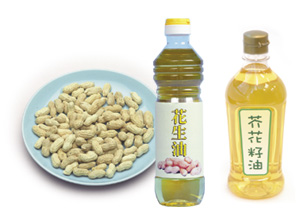
Section 3 of the Regulations stipulates that aflatoxin, erucic acid and malachite green are harmful substances. Any food other than peanut or its products shall contain no more than 15 micrograms of aflatoxin per kilogram of the food while peanuts or peanut products shall contain no more than 20 micrograms of aflatoxin per kilogram of the food.
Erucic acid is the main fatty acid of canola oil and other Brassicaceae seed oil. Tests on laboratory animals found that excessive intake of erucic acid may damage their heart tissue. Erucic acid in any food containing oil or fat (including food to which oil has been added) shall not exceed 5 per centum by weight of the total fatty acid content.
Malachite green has been included in the Regulations. All food for sale in Hong Kong shall not contain any malachite green.
Under the Regulations, any person who imports, manufactures or sells any food containing aflatoxin or erucic acid in greater concentration than that mentioned above, or any food containing malachite green (including live fish, live reptile and live poultry) commits an offence and is liable to a maximum fine of $ 50,000 and to imprisonment for 6 months.